 Computer Tutorials
Computer Tutorials
 Computer Knowledge
Computer Knowledge
 Ten Discussions on Linux High-Performance Network Programming
Ten Discussions on Linux High-Performance Network Programming
Ten Discussions on Linux High-Performance Network Programming
"Ten Talks on Linux High-Performance Network Programming" has been written for a few months. The ten technical blogs have been written. I thought I would write a summary to review my work in the past few years. In other words, the two experiences in Goose Factory add up. It has been almost 8 years. Although I spend a lot of time working on screws, I still learned a lot from my experience in the evolution of high-performance architecture, from participation, optimization to final design of the architecture.

1. Design in advance or business evolution?
Everyone should have experienced the process of a project from 0 to 1. I would like to ask a question: In many cases, is the architecture evolving with the business or is it designed in advance?
Someone may have studied related architecture books. Most of these books believe that architecture evolves with business development. However, there are also many architects who insist that architecture should be designed in advance. Here, I will not draw conclusions for the time being, but explore the evolution of the architecture through my own experience.
2. From PHP to C
2.1 Simple PHP architecture
PHP, as a simple and convenient language, should be present in all departments of large factories. At that time, I used two languages for work: C and PHP. Using PHP to develop functions is very fast, and there are many mature libraries, so It forms the classic nginx
php-fpm memcache architecture.
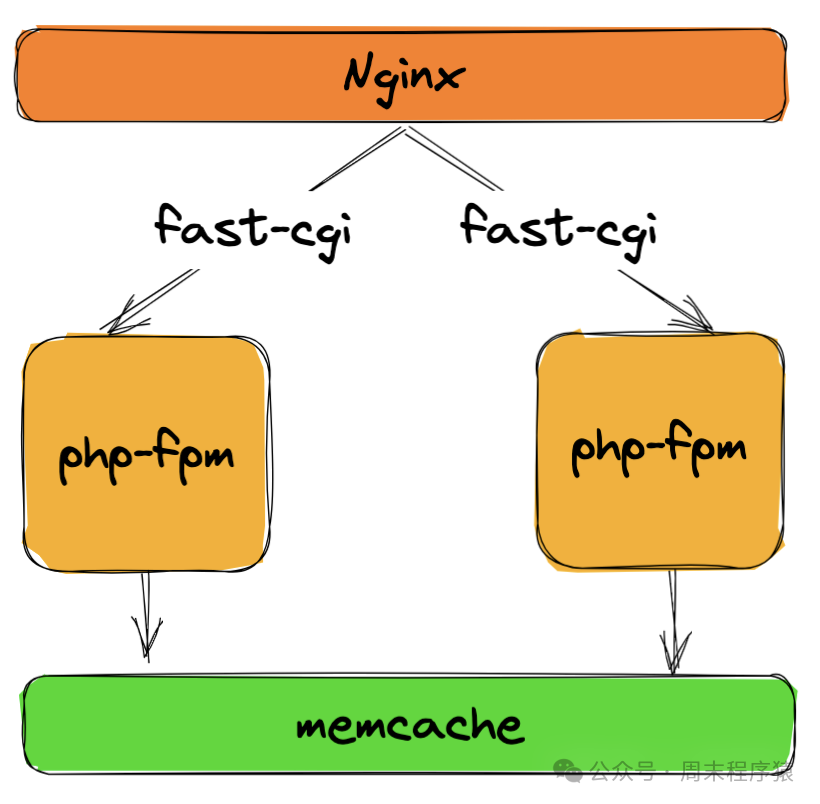 php architecture
php architecture
Under the current architecture, it is not a big problem for a single 8c8g machine to support 1000qps, so for the business, it is currently less than 1wqps. Obviously, a few more machines can support it. Regarding the design of the cache layer, when redis was not yet well developed, memcache was the mainstream cache component at that time, and it was simple for business and docking with PHP. However, with the development of business, according to the calculation curve at that time, it may reach 5wqps within a year. Is it reasonable to use nginx
php-fpm memcache architecture? After discussion, the goal is high performance on the server side, so we started high-performance A journey of discovery.
2.2 Multi-process framework
At that time, in order to implement a high-performance server-side framework, people tried some solutions. One of them was to use the PHP plug-in function to integrate Server functions into the scripting language. This approach achieves the goal of high performance to a certain extent. For example, PHP's swoole is now a development result of this method.
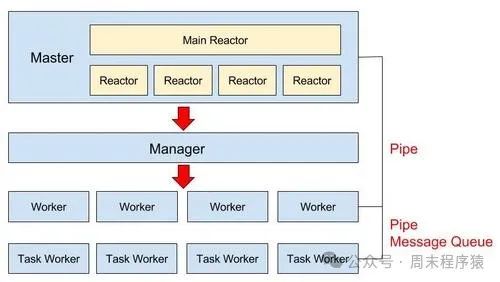 php-server
php-server
However, there will be some problems that need to be solved here:
- Be familiar with the usage scenarios of PHP extensions and avoid pitfalls
- Memory leak problem in the use of PHP itself
- The cost of troubleshooting when a problem occurs. For example, once a problem occurs, we sometimes need to understand the PHP source code, but when facing hundreds of thousands of lines of code, this cost is quite high
- PHP is simple to use. This is actually relatively true. With the rise of Docker, the stand-alone era will inevitably pass. Can the PHP ecosystem support it?
- …
Based on the above thinking and analysis of business development, it is actually more reasonable for us to implement a server ourselves or use the existing C framework to implement a set of business layer servers. Therefore, after consideration, we adopted the SPP framework within the company. Its architecture is as follows :
 SPP Framework Architecture
SPP Framework Architecture
It can be seen that SPP is a multi-process architecture. Its architecture is similar to Nginx and is divided into Proxy process and Worker process, among which:
- The proxy process uses handle_init to perform initialization, handle_route is forwarded to the worker processing process specified for execution, and handle_input handles the incoming packet of the request
- The worker process uses handle_init to perform initialization, handle_process processes the package and business logic and returns
After using the C architecture, the single-machine performance is directly improved to 6kqps, which basically meets the performance requirements. It can support more businesses on the same machine. It seems that the architecture can be stabilized.
2.3 Introducing coroutines
Using C has met the performance requirements, but there are many problems in development efficiency, such as accessing redis. In order to maintain the high performance of the service, the code logic uses asynchronous callbacks, similar to the following:
... int ret = redis->GetString(k, getValueCallback) ...
GetValueCallback is the callback function. If there are many io operations, the callback here will be very troublesome. Even if it is encapsulated in a similar synchronization method, it will be very troublesome to handle. At that time, std::future and std::async were not introduced.
On the other hand, based on the subsequent qps that may reach 10~20w level, coroutines will also have more advantages in the performance of multi-IO service processing, so we started to transform the coroutine method, replacing all io places with Coroutine calling, for business development, the code becomes like this:
... int ret = redis->GetString(k, value) ...
The value is the return value that can be used directly. Once there is io in the code, the bottom layer will replace io with the API of the coroutine, so that all blocked io operations become synchronization primitives, and the code structure is Development efficiency has been greatly improved (for specific coroutine implementation, please refer to the series of articles "Ten Talks on Linux High-Performance Network Programming | Coroutines").
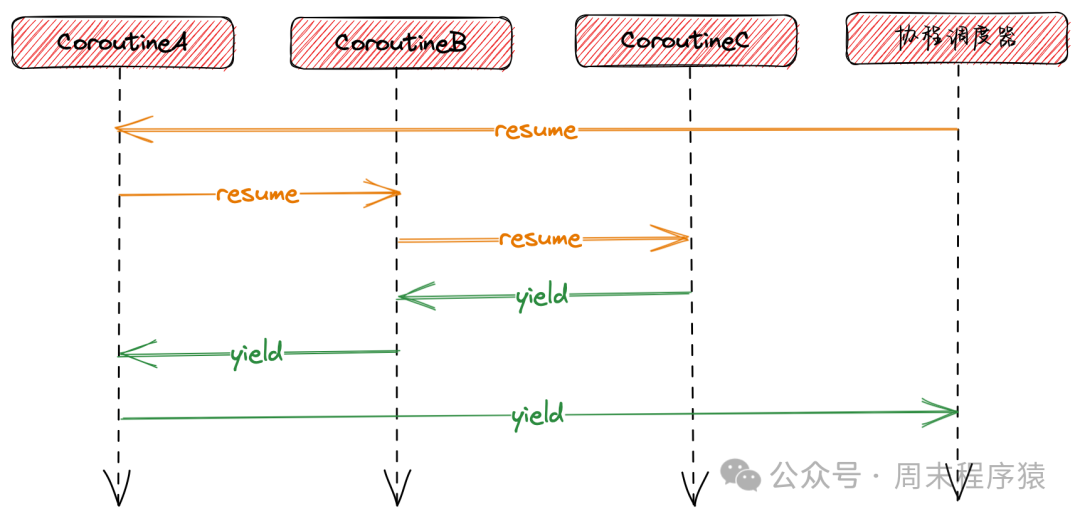 Coroutine
Coroutine
There are still not many changes in the architecture. The multi-process coroutine method has supported business development for several years. Although there is no exponential growth in performance, it has gained more experience in high-performance exploration and precipitation.
3. Cloud native
Business continues to develop, and engineers are always pursuing the most cutting-edge concepts. Cloud native, as a popular technology point in recent years, will naturally not be ignored. However, before entering cloud native, if your team does not have a DevOps development concept , this will be a painful process that requires repaying technical debt on architectural design and framework selection.
3.1 Implement DevOps concept
I used to consider high performance when doing architecture. As I understood the architecture, I discovered that high performance is only a small area of architecture design. If you want to build a good architecture, you need more agile processes and service governance concepts. Specific considerations. Summarized as follows:
- Continuous Integration: Developers integrate code into a shared repository multiple times a day, and every isolated change to the code is immediately tested to detect and prevent integration issues
- Continuous Delivery: Continuous Delivery (CD) ensures that each version of code tested in the CI repository can be released at any time
- Continuous deployment: This includes grayscale deployment, blue-green release, etc. The purpose is to quickly iterate. After relatively complete integration testing, grayscale verification can be performed
- Service discovery: Turn services into microservices and simplify calls between services
- RPC framework: The server framework that pursues high performance also needs to consider the support of basic components such as current limiting and circuit breakers
- Monitoring system: Integrate Promethues, OpenTracing and other functions to quickly discover online problems in the agile development process
- Containerization: In order to unify the environment and consider cloud native scenarios in advance, containerization is essential in the development process
- …
 DevOps
DevOps
At this point, you will find that a simple high-performance server has become the goal of the architecture, so it is necessary to re-investigate and design the architecture to successfully implement the DevOps concept.
3.2 Multi-threading
Based on DevOps, combined with the above C Server framework, it is found that multi-process can no longer meet the needs of the architecture. The reasons are as follows:
- Multiple processes are not consistent with the single-process concept of Docker containers
- Working processes have uneven load, how to make better use of multi-cores
- Effective connection with monitoring system
- Business configuration is loaded repeatedly and the configuration center needs to be re-adapted
- It is not very reasonable to use multiple processes to provide stateful services
- …
The business has also grown to one million QPS. In order to better service management and service call costs, we have to consider another architecture:
(1)Research gRPC
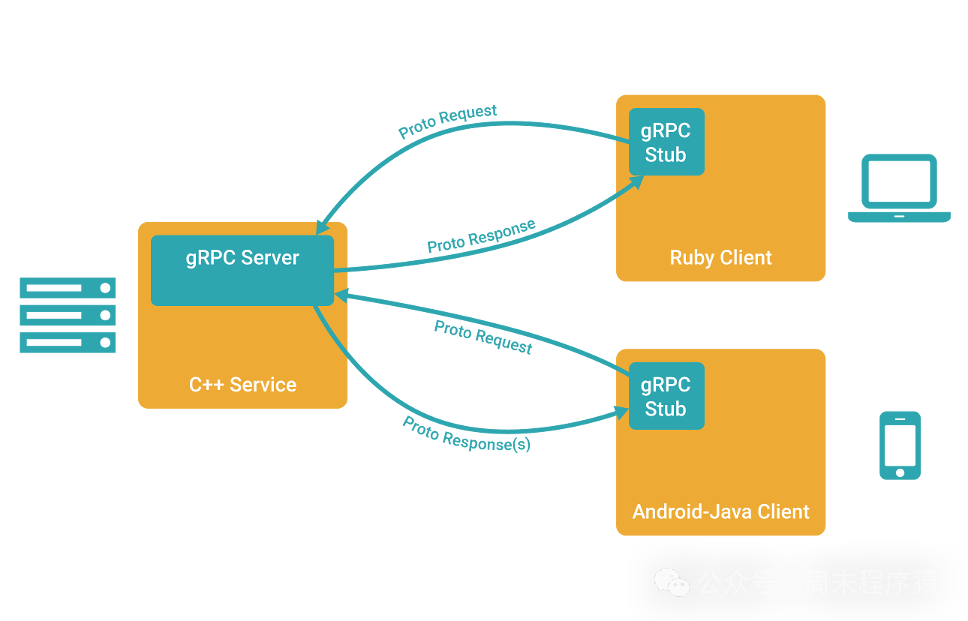 gRPC
gRPC
gRPC is a multi-threaded RPC
Server. It has a mature ecosystem, various middleware, supports multiple languages, etc. It is a good choice for business development from 0 to 1, but it faces challenges for business migration. For example, developing your own middleware adaptation service discovery, configuration center, etc., transforming the protocol according to custom encoding and decoding, how to combine coroutines, etc. Therefore, it can be satisfied for some businesses, but it still needs to be better integrated with the RPC
of components within the company. Server.
(2)Use tRPC
It happened that tRPC was being developed in the company. After research, we found that it basically met the needs, so we tried to adapt the C version of tRPC to our system in the early stages of development. After a series of transformations, the high-performance RPC framework was migrated to the business system. and used the tRPC architecture:
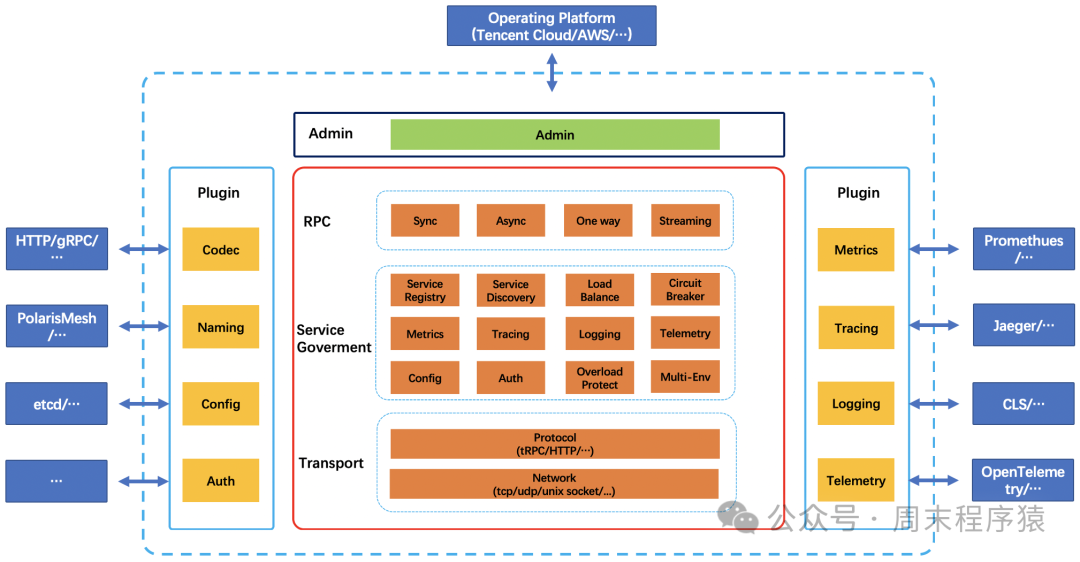
https://trpc.group/zh/docs/what-is-trpc/archtecture_design/
Based on the above considerations and business development, we began to try to unify the RPC Server framework based on high performance to adapt to subsequent RPC diversified scenarios, so we implemented a set of RPC that adapts to our business system
Server’s basic framework:
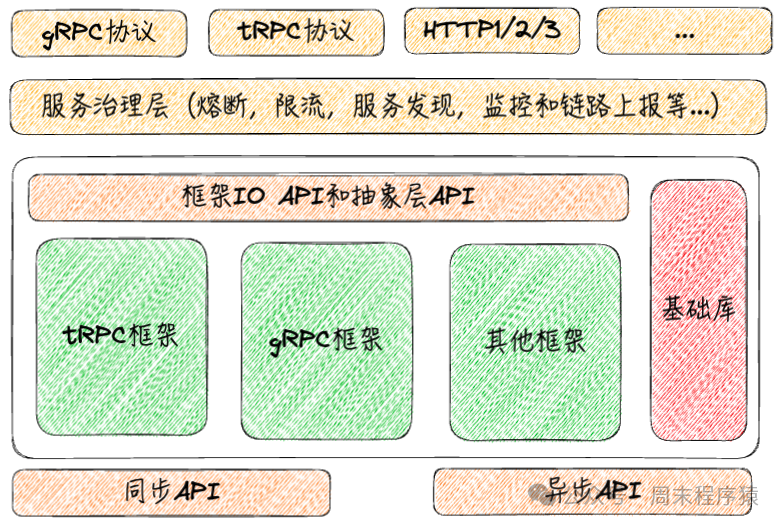 New Architecture
New Architecture
3.3, towards k8s
After going through the above selection and transformation, our services can be connected step by step during the migration to k8s. The service can run on its platform without too many transformations, and the connected platforms can also be completed. support.
It seems that we can just pursue newer technologies and wait for the next trend? In fact, there are more challenges at this time. Due to the convenience of the cloud and the disorderly expansion of the migration service architecture, business services and logical levels have become more and more complex. At the same time, the downstream links that a service relies on are getting longer and longer. Although our framework supports link tracking, the longer the link, the controllability and stability of the service will become worse and worse, and it will lead to more waste. A lot of manpower supports daily ops.
what to do?…
Should we merge the business logic and simplify the architecture? The problem here is that when the business logic is complex, the cycle often takes a long time, and the cost is relatively high, and the benefits are not very large
Is it to re-develop a new architecture, keep the decayed ones as they are or discard them, and use a new architecture to adapt to the next development?
The above is the detailed content of Ten Discussions on Linux High-Performance Network Programming. For more information, please follow other related articles on the PHP Chinese website!

Hot AI Tools

Undresser.AI Undress
AI-powered app for creating realistic nude photos

AI Clothes Remover
Online AI tool for removing clothes from photos.

Undress AI Tool
Undress images for free

Clothoff.io
AI clothes remover

AI Hentai Generator
Generate AI Hentai for free.

Hot Article

Hot Tools

Notepad++7.3.1
Easy-to-use and free code editor

SublimeText3 Chinese version
Chinese version, very easy to use

Zend Studio 13.0.1
Powerful PHP integrated development environment

Dreamweaver CS6
Visual web development tools

SublimeText3 Mac version
God-level code editing software (SublimeText3)

Hot Topics
 1382
1382
 52
52
 PHP 8.4 Installation and Upgrade guide for Ubuntu and Debian
Dec 24, 2024 pm 04:42 PM
PHP 8.4 Installation and Upgrade guide for Ubuntu and Debian
Dec 24, 2024 pm 04:42 PM
PHP 8.4 brings several new features, security improvements, and performance improvements with healthy amounts of feature deprecations and removals. This guide explains how to install PHP 8.4 or upgrade to PHP 8.4 on Ubuntu, Debian, or their derivati
 How To Set Up Visual Studio Code (VS Code) for PHP Development
Dec 20, 2024 am 11:31 AM
How To Set Up Visual Studio Code (VS Code) for PHP Development
Dec 20, 2024 am 11:31 AM
Visual Studio Code, also known as VS Code, is a free source code editor — or integrated development environment (IDE) — available for all major operating systems. With a large collection of extensions for many programming languages, VS Code can be c
 7 PHP Functions I Regret I Didn't Know Before
Nov 13, 2024 am 09:42 AM
7 PHP Functions I Regret I Didn't Know Before
Nov 13, 2024 am 09:42 AM
If you are an experienced PHP developer, you might have the feeling that you’ve been there and done that already.You have developed a significant number of applications, debugged millions of lines of code, and tweaked a bunch of scripts to achieve op
 How do you parse and process HTML/XML in PHP?
Feb 07, 2025 am 11:57 AM
How do you parse and process HTML/XML in PHP?
Feb 07, 2025 am 11:57 AM
This tutorial demonstrates how to efficiently process XML documents using PHP. XML (eXtensible Markup Language) is a versatile text-based markup language designed for both human readability and machine parsing. It's commonly used for data storage an
 Explain JSON Web Tokens (JWT) and their use case in PHP APIs.
Apr 05, 2025 am 12:04 AM
Explain JSON Web Tokens (JWT) and their use case in PHP APIs.
Apr 05, 2025 am 12:04 AM
JWT is an open standard based on JSON, used to securely transmit information between parties, mainly for identity authentication and information exchange. 1. JWT consists of three parts: Header, Payload and Signature. 2. The working principle of JWT includes three steps: generating JWT, verifying JWT and parsing Payload. 3. When using JWT for authentication in PHP, JWT can be generated and verified, and user role and permission information can be included in advanced usage. 4. Common errors include signature verification failure, token expiration, and payload oversized. Debugging skills include using debugging tools and logging. 5. Performance optimization and best practices include using appropriate signature algorithms, setting validity periods reasonably,
 PHP Program to Count Vowels in a String
Feb 07, 2025 pm 12:12 PM
PHP Program to Count Vowels in a String
Feb 07, 2025 pm 12:12 PM
A string is a sequence of characters, including letters, numbers, and symbols. This tutorial will learn how to calculate the number of vowels in a given string in PHP using different methods. The vowels in English are a, e, i, o, u, and they can be uppercase or lowercase. What is a vowel? Vowels are alphabetic characters that represent a specific pronunciation. There are five vowels in English, including uppercase and lowercase: a, e, i, o, u Example 1 Input: String = "Tutorialspoint" Output: 6 explain The vowels in the string "Tutorialspoint" are u, o, i, a, o, i. There are 6 yuan in total
 Explain late static binding in PHP (static::).
Apr 03, 2025 am 12:04 AM
Explain late static binding in PHP (static::).
Apr 03, 2025 am 12:04 AM
Static binding (static::) implements late static binding (LSB) in PHP, allowing calling classes to be referenced in static contexts rather than defining classes. 1) The parsing process is performed at runtime, 2) Look up the call class in the inheritance relationship, 3) It may bring performance overhead.
 What are PHP magic methods (__construct, __destruct, __call, __get, __set, etc.) and provide use cases?
Apr 03, 2025 am 12:03 AM
What are PHP magic methods (__construct, __destruct, __call, __get, __set, etc.) and provide use cases?
Apr 03, 2025 am 12:03 AM
What are the magic methods of PHP? PHP's magic methods include: 1.\_\_construct, used to initialize objects; 2.\_\_destruct, used to clean up resources; 3.\_\_call, handle non-existent method calls; 4.\_\_get, implement dynamic attribute access; 5.\_\_set, implement dynamic attribute settings. These methods are automatically called in certain situations, improving code flexibility and efficiency.



